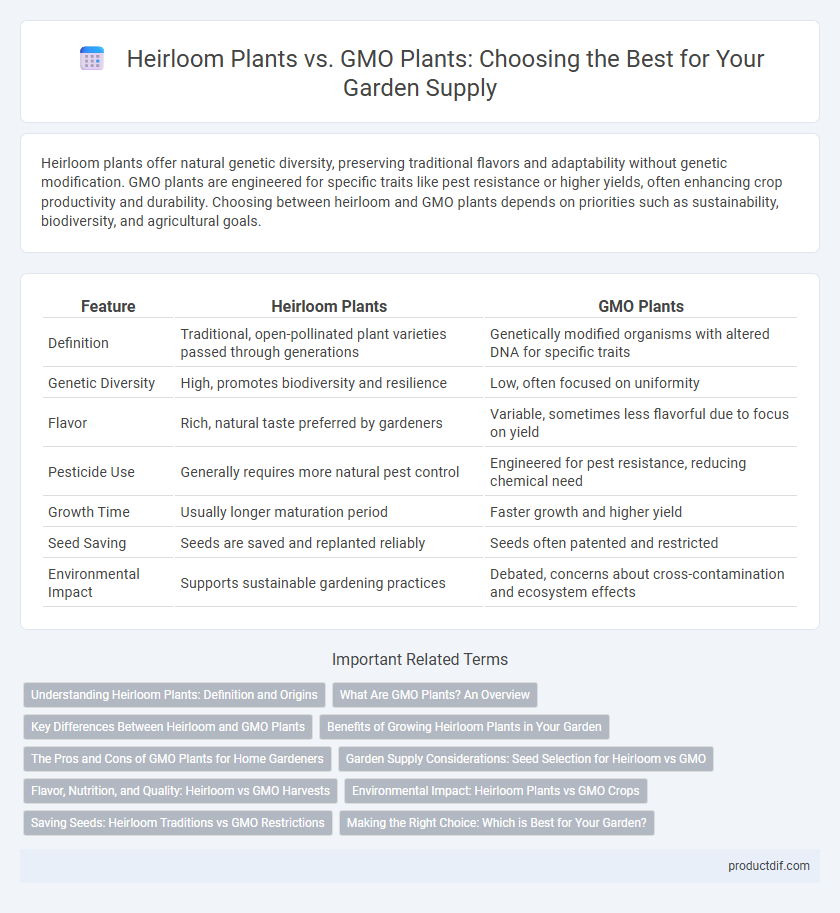Heirloom plants offer natural genetic diversity, preserving traditional flavors and adaptability without genetic modification. GMO plants are engineered for specific traits like pest resistance or higher yields, often enhancing crop productivity and durability. Choosing between heirloom and GMO plants depends on priorities such as sustainability, biodiversity, and agricultural goals.
Table of Comparison
| Feature | Heirloom Plants | GMO Plants |
|---|---|---|
| Definition | Traditional, open-pollinated plant varieties passed through generations | Genetically modified organisms with altered DNA for specific traits |
| Genetic Diversity | High, promotes biodiversity and resilience | Low, often focused on uniformity |
| Flavor | Rich, natural taste preferred by gardeners | Variable, sometimes less flavorful due to focus on yield |
| Pesticide Use | Generally requires more natural pest control | Engineered for pest resistance, reducing chemical need |
| Growth Time | Usually longer maturation period | Faster growth and higher yield |
| Seed Saving | Seeds are saved and replanted reliably | Seeds often patented and restricted |
| Environmental Impact | Supports sustainable gardening practices | Debated, concerns about cross-contamination and ecosystem effects |
Understanding Heirloom Plants: Definition and Origins
Heirloom plants are open-pollinated varieties passed down through generations, valued for their historical significance and genetic diversity. These plants originate from seeds that have been preserved and cultivated for at least 50 years, often reflecting the agricultural heritage of specific regions. Unlike GMO plants, heirloom varieties maintain natural genetic traits without modern genetic modification, ensuring the preservation of unique flavors, colors, and resilience.
What Are GMO Plants? An Overview
GMO plants are genetically modified organisms created by altering their DNA to exhibit specific traits such as pest resistance, herbicide tolerance, or enhanced nutritional content. These plants are engineered using advanced biotechnology techniques that enable precise gene insertion or deletion, differentiating them from traditional heirloom varieties that rely on natural breeding. GMO plants offer benefits in agricultural productivity and resilience but often raise concerns regarding environmental impact and genetic diversity preservation in garden supply practices.
Key Differences Between Heirloom and GMO Plants
Heirloom plants are open-pollinated varieties passed down through generations, prized for their genetic diversity, unique flavors, and adaptability to local environments, whereas GMO plants are genetically engineered for traits like pest resistance, herbicide tolerance, and increased yield. Heirlooms maintain genetic stability and can be saved and replanted by gardeners, while GMO plants often contain patented genes restricting seed saving and replanting. The fundamental difference lies in heirlooms preserving natural genetic heritage versus GMOs being modified at the molecular level to express specific, desirable traits.
Benefits of Growing Heirloom Plants in Your Garden
Growing heirloom plants in your garden preserves genetic diversity and enhances flavor complexity often lost in GMO varieties. Heirloom plants offer adaptability to local climates and resistance to regional pests, reducing the need for chemical interventions. Cultivating these plants supports sustainable gardening practices and safeguards agricultural heritage for future generations.
The Pros and Cons of GMO Plants for Home Gardeners
GMO plants offer home gardeners benefits such as enhanced resistance to pests, diseases, and environmental stresses, which can lead to higher yields and reduced pesticide use. However, concerns include potential impacts on biodiversity, cross-contamination with heirloom varieties, and limited seed-saving options due to proprietary restrictions. Careful consideration of these pros and cons helps gardeners make informed choices aligned with sustainability and personal gardening goals.
Garden Supply Considerations: Seed Selection for Heirloom vs GMO
Heirloom plants offer unique genetic diversity and flavor profiles, making them a favored choice for gardeners seeking open-pollinated, non-hybrid seeds that can be saved and replanted annually. GMO plants, engineered for traits like pest resistance and higher yields, may require purchasing new seeds each season, impacting long-term garden supply costs and sustainability. Garden supply considerations include seed availability, cost, and the gardener's preference for natural propagation methods versus engineered crop performance.
Flavor, Nutrition, and Quality: Heirloom vs GMO Harvests
Heirloom plants often deliver superior flavor profiles and higher nutrient density compared to many GMO plants, which are typically engineered for yield and pest resistance rather than taste or nutrition. Studies show heirloom varieties exhibit richer aromas and complex textures, enhancing culinary experiences and providing diverse phytonutrients. While GMOs contribute to agricultural efficiency, heirloom harvests maintain traditional quality traits prized by gourmets and health-conscious consumers.
Environmental Impact: Heirloom Plants vs GMO Crops
Heirloom plants promote biodiversity by preserving traditional seed varieties that adapt naturally to local ecosystems, reducing the need for chemical inputs and supporting pollinators. GMO crops often require heavy use of herbicides and pesticides, which can lead to soil degradation, water contamination, and loss of beneficial insect populations. Choosing heirloom plants contributes to sustainable gardening practices and helps maintain ecological balance compared to the environmental risks associated with genetically modified organisms.
Saving Seeds: Heirloom Traditions vs GMO Restrictions
Saving seeds from heirloom plants preserves genetic diversity and traditional plant traits, allowing gardeners to maintain a sustainable and self-reliant seed supply. GMO plants often come with legal restrictions and patented genes, preventing the saving and replanting of seeds and limiting gardeners' independence. Embracing heirloom seed saving supports biodiversity and agricultural heritage, while GMO restrictions emphasize controlled cultivation and corporate ownership.
Making the Right Choice: Which is Best for Your Garden?
Heirloom plants offer genetic diversity and rich flavors, preserving traditional varieties ideal for sustainable gardening. GMO plants provide disease resistance and higher yields, enabling gardeners to tackle pests and climate challenges effectively. Choosing between heirloom and GMO plants depends on your garden's goals, whether prioritizing biodiversity or maximizing productivity.
Heirloom Plants vs GMO Plants Infographic

 productdif.com
productdif.com